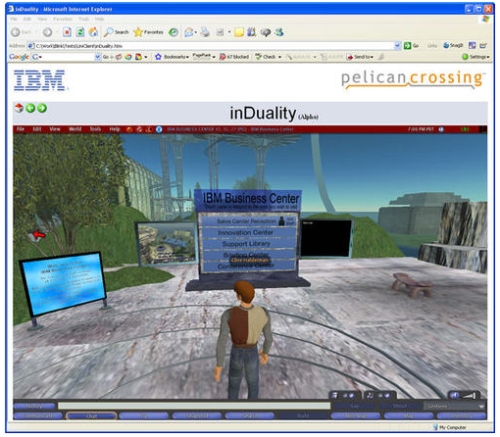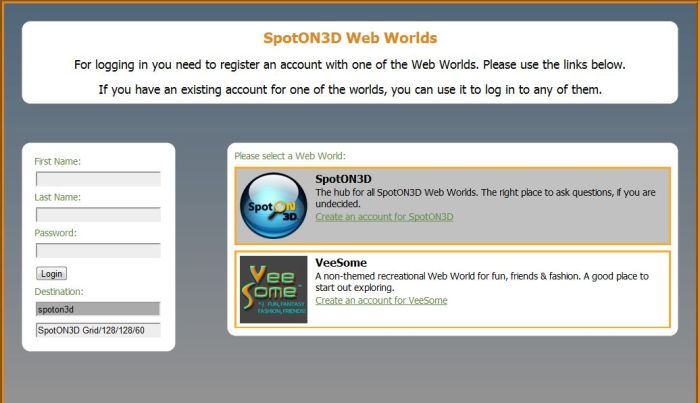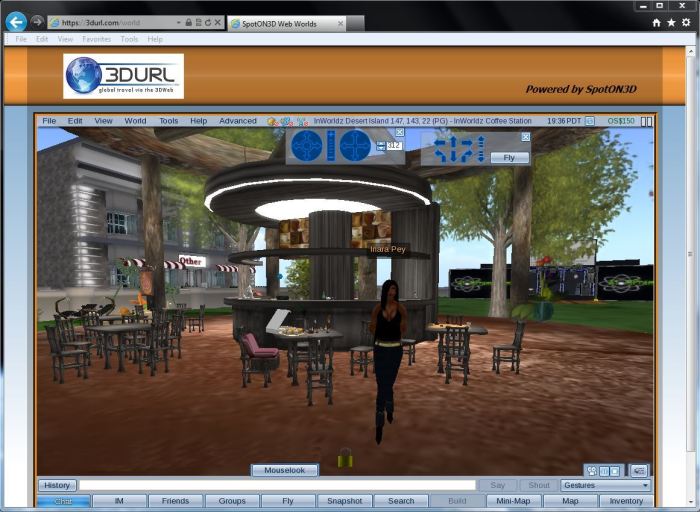There has been much to-do around SpotON3D’s plugin to present the Viewer through a browser / Facebook page. Specifically, the furore has been around SpotON3D’s revelation that they have filed a patent application for the technology. A lot of this furore has been on the matter of prior art existing around the concept of a web browser plugin (the inDuality product is frequently pointed to), and the fact that others in the OpenSim environment have been working towards similar capabilities. Another cause for upset has been the perception that SpotON3D are using the fact that they have filed for a patent on the technology as an anti-competitive roadblock to discourage others from working on the same idea out fear of facing financial penalty should the SpotON3D patent in fact be granted at some point in the future.
SpotON3D have twice made efforts to directly address concerns in these matters through face-to-face group meetings. The first of these was held on their own grid, and was not a roaring success due to a number of reasons. The second attempt was held last night at their Content Creator’s Expo being held in Second Life. Hosted by Tessa Kinney-Johnson, SpotON3D’s COO and Stevan Lieberman, SpotON3D’s CEO, this also wasn’t an inspiring success.
A major reason for this was the seeming unwillingness for those at SpotON3D to actually engage with others on specifics (i.e. what area(s) of technology they are patenting), repeatedly deferring such discussions until the patent is published. Instead, they would only go so far as to circle around what the patent may not be, and the patent process itself. I say “may not” here, because the answers Stevan Lieberman gave last night were vague because as he himself put, it, “I don’t fully understand all of the technology”.
While this may well be true, it also came across to some as evasiveness: SpotON3D called the meeting, have seen the questions that have been asked repeatedly in public forums (which they’ve previously refused to answer), and so should have been somewhat better prepared to deal with this kind of question a little more openly.
 Obviously, there are reasons for SpotON3D not to go into specifics – just as any company filing a patent application would avoid discussing precise details, simply because doing so would tip-off “the competition” and lead to complications through the patent process etc. However, while this attitude may well appear to be right and proper from a legal perspective (Lieberman is himself an intellectual property attorney), it tends to demonstrate a lack of understanding of the environment in which his company is working. This was exacerbated by his refusal, as the conversation broadened, to indicate two further patent applications SpotON3D is in the process of filing.
Obviously, there are reasons for SpotON3D not to go into specifics – just as any company filing a patent application would avoid discussing precise details, simply because doing so would tip-off “the competition” and lead to complications through the patent process etc. However, while this attitude may well appear to be right and proper from a legal perspective (Lieberman is himself an intellectual property attorney), it tends to demonstrate a lack of understanding of the environment in which his company is working. This was exacerbated by his refusal, as the conversation broadened, to indicate two further patent applications SpotON3D is in the process of filing.
In many respects, what we have here is both a failure to communicate – and in fairness, this is not just SpotON3D’s fault, although they do carry the brunt of responsibility and they’ve managed to turn this entire situation into something of a PR disaster as a result. I could go on at length as to why, but Maria Korolov has been me to the punch in expressing why this is so, and her comments are an excellent read on the matter.
Simply put, SpotON3D are doing themselves no favours – not so much by filing this (and other patents), although some may well differ within me in this opinion – but in the manner in which they are both interacting with, and reacting to, the OpenSim community as a whole. In this regard, were I to point out just one aspect of the advice Maria gives to SpotON3D to help alleviate matters, it would be this:
Give something back to the community. Now.
Much of the damage SpotON3D have done to themselves stems from the fact that they appear to constantly come up with reasons not to give back to the community they claim to be a part of. Yes, they have plans to do so “next year”, but that simply isn’t enough. They need to be seen to be contributing now, and moving away from what appears to be repeatedly citing reasons why they cannot.
In this, SpotON3D further haven’t helped generate a feeling that they are working openly with the rest of the community as they’ve recently taken steps to lock-down the plugin so that the Viewer no longer supports the ability to access other grids when displayed through the plugin. Whatever the reasons for doing so, it doesn’t really measure=up to SpotON3D’s claims of openness towards the greater community.
Beyond this, the company needs to offer more of an olive branch if they want to be be seen as being genuine in their efforts to broker greater understanding and cooperation. This may sound unfair to those at SpotON3D, who may well feel as if they have attempted to reach out on at least two occasions, only to receive a rap across the knuckles, and had to face-up to placard-wavers and the like. But the move really has to come from them, and demonstrate they themselves are willing to bring something to the table that can be discussed.
And with the greatest of respect to Tessa and Stevan, they need to ensure that whoever does this is a) fully briefed on all aspects of the technology and the kind of questions they are liable to face – and be prepared to provide answers; and b) is able to engage with people positively and with both openness and empathy.
Further Reading
- SpotON3D’s five PR-Mistakes – Hypergrid Business
- A video of the SL-based meeting held on the 19th August – The Great Imbalance
- My personal view of the storm around SpotON3D – Philippe Pascal, SpotON3D’s Developer Program Manager’s personal blog
- SpotON3D forum ends in tears – Hypergrid Business
- SpotON3D responds to patent concerns will license plugin to other grids/ – Hypergrid Business





